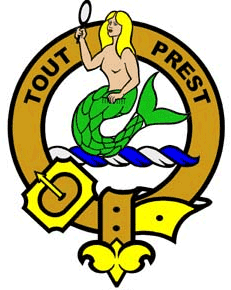Murray Clan
Murray Clan Crest: A mermaid holding a mirror in her dexter hand and a comb in the sinister.
Murray Clan Motto: Tout Prest (Quite ready).
History of Clan Murray:
Freskin de Moravia, a Flemish nobleman in the 12th century, is the ancestor of this Clan. In all probability, he accompanied David I on his return from England to Scotland in 1124. Freskin was granted lands in West
Lothian and Moray, and to consolidate his position, he and his sons married into the ancient Royal House of Moray. Thereafter, in old Charters, the family name appears as de Moravia.
William de Moravia , son of Freskin, was witness to a Royal Charter to the Abbey of Holyrood in 1203. His descendant, Walter de Moravia, married the heiress of Bothwell and Drumsagard in Lanarkshire, and Smailholm
in Berwickshire and, in 1255, was one of the Regents of Scotland during the minority of Alexander III.
In 1296, another Sir William, Sir Andrew and Hugh de Moravia rendered homage to Edward I. However, the following year Sir Andrew joined Sir William Wallace's resistance movement and was one of his most brilliant generals, leading the Scots to victory against the English at the Battle of Stirling Bridge, although he himself was killed in the action. Sir Andrew's son died at the Battle of Halidon Hill in 1333, and his grandson died of the plague in 1360, after which his widow married the 3rd Earl of Douglas and ownership of Bothwell Castle passed to the house of Douglas.
The de Moravias spawned many distinguished branches carrying the surname of Murray – the Murrays of Blackbarony, Duncroe, Ochtertyre and Abercairney, the latter acquired through marriage to a daughter of the Royal House of Strathearn in the 14th century.
In 1600, Sir David Murray, Captain of the Guard for James VI, was granted the lands of Scone in Perthshire by James VI. Having accompanied the King to England, he was created Viscount Stormont in 1621. At Scone is the hill where tradition has it that all Kings of Scots, after the 6th Century and prior to the 17th Century, were crowned, and it was here that Charles II was proclaimed King in 1651.
William, third son of the 5th Viscount Stormont, became Lord Chief Justice of England and, in 1776, was created Earl of Mansfield. In 1643, Sir Patrick Murray, son of Sir Gideon Murray of Elibank was created Baron Elibank. In 1911, Commander Montolieu Fox Oliphant Murray, 10th Lord Elibank, was created Viscount Elibank, but this title became extinct on the death of his younger son. In 1912, his son, a Liberal politician, was created Lord Murray of Elibank, but predeceased his father.
Sir George Murray (1772-1846) was Member of Parliament for Perth and subsequently was appointed Governor of Canada. Alexander Murray (1775-1813, born in Kirkcudbrightshire, wrote a History of the European Languages.
John Murray (1778-1843) founded the publishing company bearing his name.
Sir David Murray (1849-1933) was a notable landscape painter. Charles Murray (1864-1941) was an acclaimed Scottish poet.
Sir James Augustus Murray (1837-1915) edited the Philosophical Society's New English Dictionary.
George Gilbert Murray (1866-1957) was a classical scholar and author. He was Professor of Greek at Glasgow University and Regius Professor of Greek at Oxford.
Surname distribution in Scotland: The Murray name is commonly across the width and breadth of Scotland with particularly high concentrations in Aberdeenshire, Aberdeen City, Moray (includes large parts of historic Banffshire), Highland (incorporates the historic counties of Caithness, Inverness-shire, Nairnshire, Ross and Cromarty, Sutherland and small areas of Argyllshire and Morayshire), the Outer Hebrides (the major islands include Lewis and Harris, North Uist, South Uist, Benbecula and Barra) and Dumfries and Galloway (Dumfriesshire, Kirkcudbrightshire and Wigtownshire).
Place of Interest:
Bothwell Castle, Lanarkshire. Built by William de Moravia in the 13th century. It was held by the Murrays until 1360, when it passed to the Douglases.
Duffus Castle, Lossiemouth, Morayshire. Fourteenth century stronghold of the de Moravia family.
Scone Palace, Perth, Perthshire. Ancient site for Coronations of Scottish kings. Today's mansion house was built in 1803, but incorporates older buildings. It is the seat of the Murray earls of Mansfield and Mansfield.
Associated family names (Septs): Balneaves, Dinsmore, Dunbar, Dunsmore, Fleming, Moray, Murrie, Neaves, Piper, Pyper, Smail, Smale, Small, Smeal, Spalding.
Clan Murray members display certificates.

